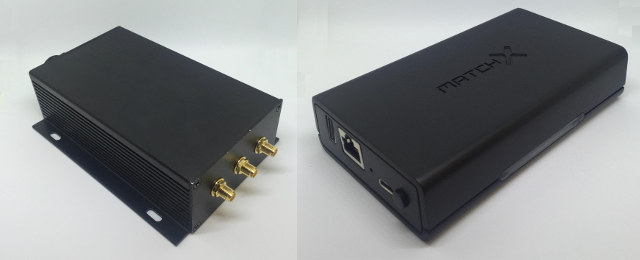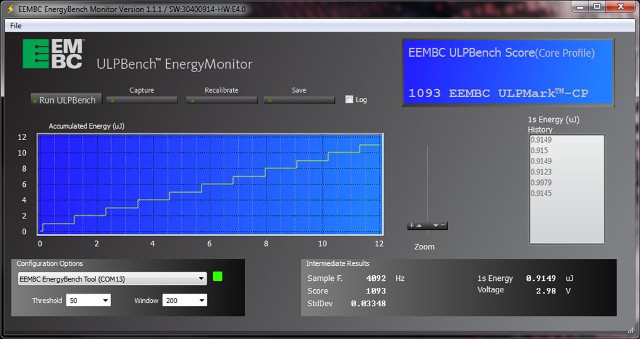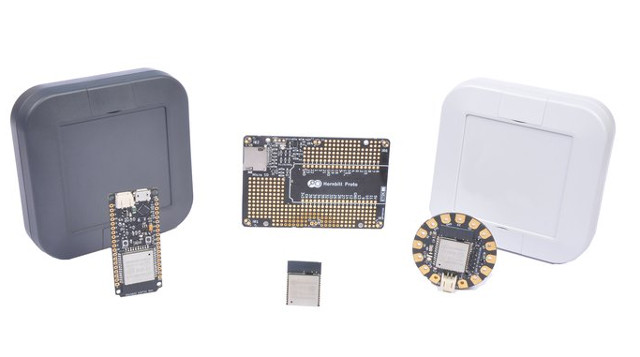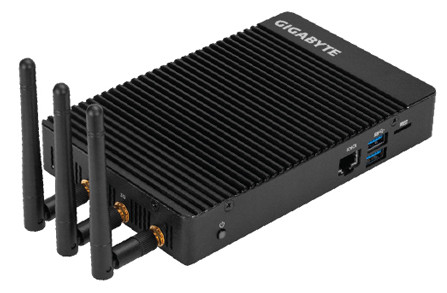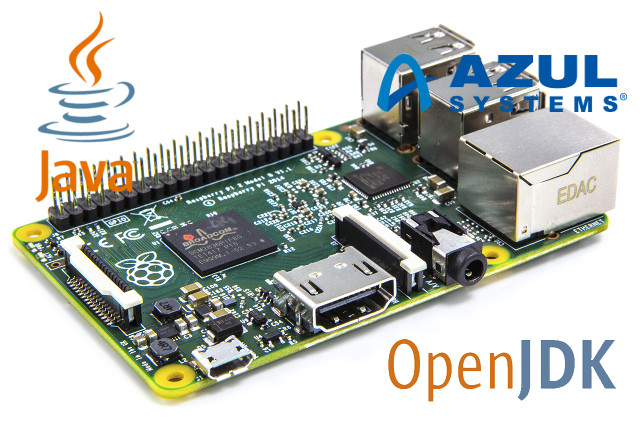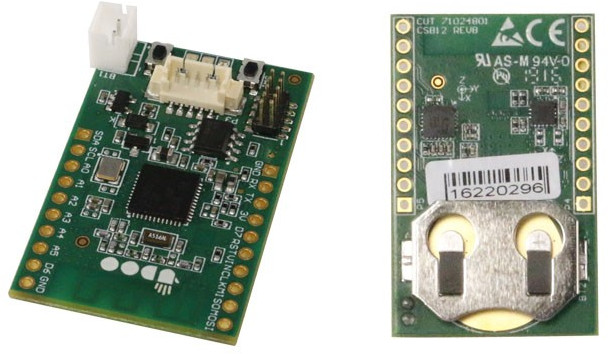MatchX is a startup with offices in Chicago, Shenzhen, and Berlin, that provides a complete LoRaWAN solution with their MatchBox gateway based on SX1301 concentrator and Mediatek MT7628N processor, as well as MatchStick, MatchModule, and MatchCore sensors with up to 65,535 of those connecting to a single gateway. MatchBox LoRaWAN/WiFi/GPRS/GPS Gateway MatchBox specifications: Processor – Mediatek MT7628AN MIPS WiSoC @ up to 580 MHz System Memory – 128MB DDR2 RAM Storage – 16MB FLASH Connectivity LoRa – Semtech SX1301 + 2x SX1257@+27dbm Output Power; 470/868/915Mhz frequency range, -146dBm sensitivity 10/100M Ethernet 802.11n 2×2 WiFi @ 300 MHz Optional GPRS via SIM800H, 85.6 kbps (downlink/uplink) + micro SIM card slot GPS via UBlox Max 7C Antennas – 2x u.FL antennas for WiFi, u.FL or chip antenna for LoRa, GPS and GPRS modules USB – 1x USB 2.0 port, 1x USB type C exposing 4 or 6 GPIOs and UART Misc – […]
EEMBC IoT-Connect is a Family of Benchmarks Designed To Test the Power Efficiency of IoT Devices
EEMBC, the Embedded Microprocessor Benchmark Consortium, has been providing benchmarks for embedded systems since 1996, including ULPBench helping to rank micro-controllers by their power efficiency. But with the Internet of Things gaining traction, it’s important to test more than just the MCU core’s power efficiency, and having a benchmark taking sensors and connectivity into account would be useful. That’s exactly what EEMC IoT-Connect benchmark family aims for with the three main characteristics: Provides flexibility to accommodate various communication protocols (e.g. Bluetooth, Thread, LoRa, WiFi) Portable to work with any vendor’s microcontroller and radio-module products Compatible with EEMBC ULPBench and EEMBC IoT-Secure benchmarks The first benchmark of the family is IoTMark-BLE connectivity profile that supports Bluetooth (LE) MCUs. The benchmark requires fixed payload size, frequency of transmission, and transmit power, and performs a complete sequence of event ranging from sensor reading, to BLE notifications, and command write and CRC. The IoT-Connect […]
Particle Asset Tracker Kit v2 2G/3G GPS Location Tracker Supports Grove Modules
Particle, the maker of IoT boards such as Electron 2G/3G module, has launched it second Asset Tracker Kit – based on Electron – with a smaller case, improved GPS performance, satellite support for GPS, GLONASS, Galileo & BeiDou, and compatibility with Seeed Studio Grove modules. Asset Tracker Kit v2 hardware specifications: MCU – STMciro STM32F205 ARM Cortex M3 micro-controller @ @ 120 MHz with 1MB Flash, 128K RAM Cellular Connectivity – U-Blox SARA U-series (3G) or G-series (2G) modem + NanoSIM card slot + u.FL connector for Antenna Location 72-channel u-bloxM8 engine with support for GPS/QZSS L1 C/A, GLONASS L10F, BeiDou B1I, Galileo E1B/C, SBAS L1 C/A: WAAS, EGNOS, MSAS, GAGAN Update rates: Single GNSS: up to 18 Hz, 2 Concurrent GNSS: up to 10 Hz Position accuracy of 2.5 m, sensitivity of -167 dBm Acquisition times: Cold starts: 26s, Aided starts: 2s, Reacquisition: 1s On board ceramic GPS antenna […]
MYIR MYS-6ULX is a $25 Single Board Computer based on NXP i.MX 6ULL/6UL Processor for IoT and Industry 4.0
MYIR Tech has released MYS-6ULX single board computer based on NXP i.MX 6ULL/6UL Cortex-A7 processor designed for either Industry 4.0 with MYS-6ULX-IND model, or the Internet of Things for MYS-6ULX-IOT. Both boards include 256MB DDR3 SDRAM, 256MB NAND flash, USB, USB, Ethernet, LCD interfaces and more, in a compact 70 x 55mm form factor. Both boards have very similar specifications. Features MYS-6ULX-IND MYS-6ULX-IOT SoC NXP i.MX 6UltraLite (MCIMX6G2CVM05AA) with an ARM Cortex A7 processor @ up to 696 MHz and 2D graphics accelerator NXP i.MX 6ULL (MCIMX6Y2DVM05AA) with an ARM Cortex A7 processor @ 528 MHz and 2D graphics accelerator DDR3 256MB (support up to 2GB) NAND Flash 256MB (support 512MB/1GB) eMMC DNP (Do Not Populate – Reserved design for optional 4GB flash) Ethernet 10/100Mbps USB 1x USB Host, 1x micro USB OTG Micro SD Card 1x Micro SD card slot Buttons 1x Reset Button, 1x User Button LED 1x Power Indicator, 2x […]
Hornbill ESP32 Development Boards Come with an Optional IP67 Rated Enclosure (Crowdfunding)
While there are plenty of ESP32 development boards, and prices have recently plummeted, getting a case for your project can still be a problem especially if you plan to use it outdoor, as you need to protect your hardware from rain and dust. Hornbill project offers two ESP-WROOM-32 based boards, a prototype board, and an IP67 certified case that could be useful for outdoor use. Hornbill ESP32 Development Boards Let’s start by checking the boards available starting with ” Hornbill ESP32 Dev” board with the following specs: ESP-WROOM-32 module with WiFi, Bluetooth LE, FCC, CE, IC, MIC (Telec), KCC, and NCC certifications I/O headers 2x 19-pin headers with GPIOs, I2C, UART, SPI, ADC, DAC, touch interface, VN/VP, 5V, 3.3V and GND Breadboard-friendly Debug – Built-in CP21XX USB-to-serial Power Supply – 5V via micro USB port, battery header + single cell LiPo charger Dimensions – TBD ESP32 Minima is also based […]
GIGABYTE BRIX IoT Apollo Lake Fanless mini PC is Designed for the Internet of Things, Digital Signage, Thin Clients
GIGABYTE has unveiled BRIX IoT mini PC powered by either Intel Celeron N3450 or Pentium N4200 processor both part of Intel’s Apollo Lake family, and as the name implied the devices target Internet of Things applications. GIGABYTE BRIX IoT specifications: SoC (one or the other) Intel Celeron N3450 quad core processor @ up to 2.2GHz with Intel HD graphics 500 (6W TDP) Intel Pentium N4200 quad core processor @ up to 2.5GHz with Intel HD graphics 505 (6W TDP) System Memory – 2x SO-DIMM DDR3L slots @ 1333/1600/1866 MHz up to 8GB Storage – 1x M.2 slot, 1x micro SD slot, optional 32 or 64GB eMMC flash Connectivity Dual Gigabit Ethernet via Realtek RTL8111HS Intel Dual band Wireless-AC 3165 module with two SMA antenna connectors 3G via mini PCIe slot and SIM card slot with one SMA antenna connector Video Output – Dual HDMI 1.4b up to 3840×2160 @ 30 […]
Azul Systems’ Zulu Embedded is a Build of OpenJDK for ARM, MIPS, PowerPC, and x86 Compliant with Java SE standard
Yesterday as I wrote about the Embedded Systems Conference 2017 schedule I came across a potentially interesting talk entitled “Building A Brain With Raspberry Pi and Zulu Embedded JVM” by Azul Systems that will explain how to build a brain emulator using a cluster of Raspberry Pi boards. I wanted to find more about it, but I have not been able to find any details about the project/demo at this stage. However, I could still learn a bit more about Zulu Embedded, which is said to be an open source Java Virtual Machine based on OpenJDK, compliant with Java SE standard, working on 32-bit & 64-bit ARM & x86, MIPS, and PowerPC, as well as multiple operating systems. Some of the key features of Zulu Embedded include: Java Support – Java 6, 7, 8, and 9 when available Java Configurations – Headless, headful, or compact Java Compact Profiles Hardware – […]
UDOO BLU and BLU SENSE IoT Modules Integrate Bluetooth LE, Zigbee, and 6LOWPAN Connectivity
UDOO is known for their Linux boards based on NXP and Intel processors for makers and the education market such as UDOO NEO or UDOO x86, but the company has now developed UDOO BLU and BLU SENSE battery powered modules based on Texas Instruments CC2650 ARM Cortex M3 microcontroller, both with Bluetooth LE, Zigbee, and 6LOWPAN connectivity, and the SENSE model adds some extra sensors. UDOO BLU and BLU SENSE specifications: Wireless MCU – Texas Instruments CC2650 ARM Cortex M3 MCU @ 48 MHz with 128KB flash, 8KB SRAM with 2.4 GHz radio Connectivity – Bluetooth Low Energy (BLE), ZigBee, 6LoWPAN Sensors (BLU SENSE only) – NXP FX0S8700CQ accelerometer & magnetometer sensor, NXP FXAS21002C gyroscope & temperature sensor Expansion 1x 5-pin sensors Snap-In I2C connector for UDOO Bricks 2x 10-pin headers with 8x Digital GPIOs, 6x ADCs, 1x I2C, 1x SPI, 1x UART Misc – 3x User Configurable LEDs (Red, […]


